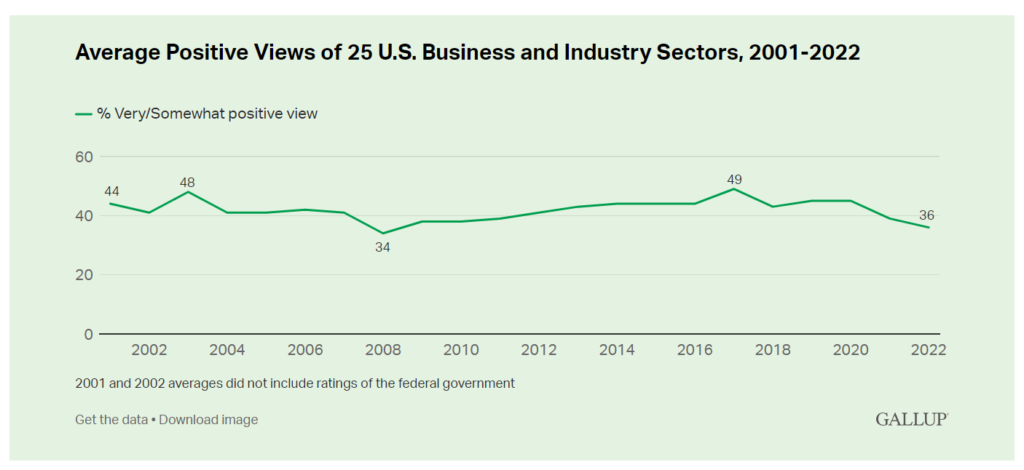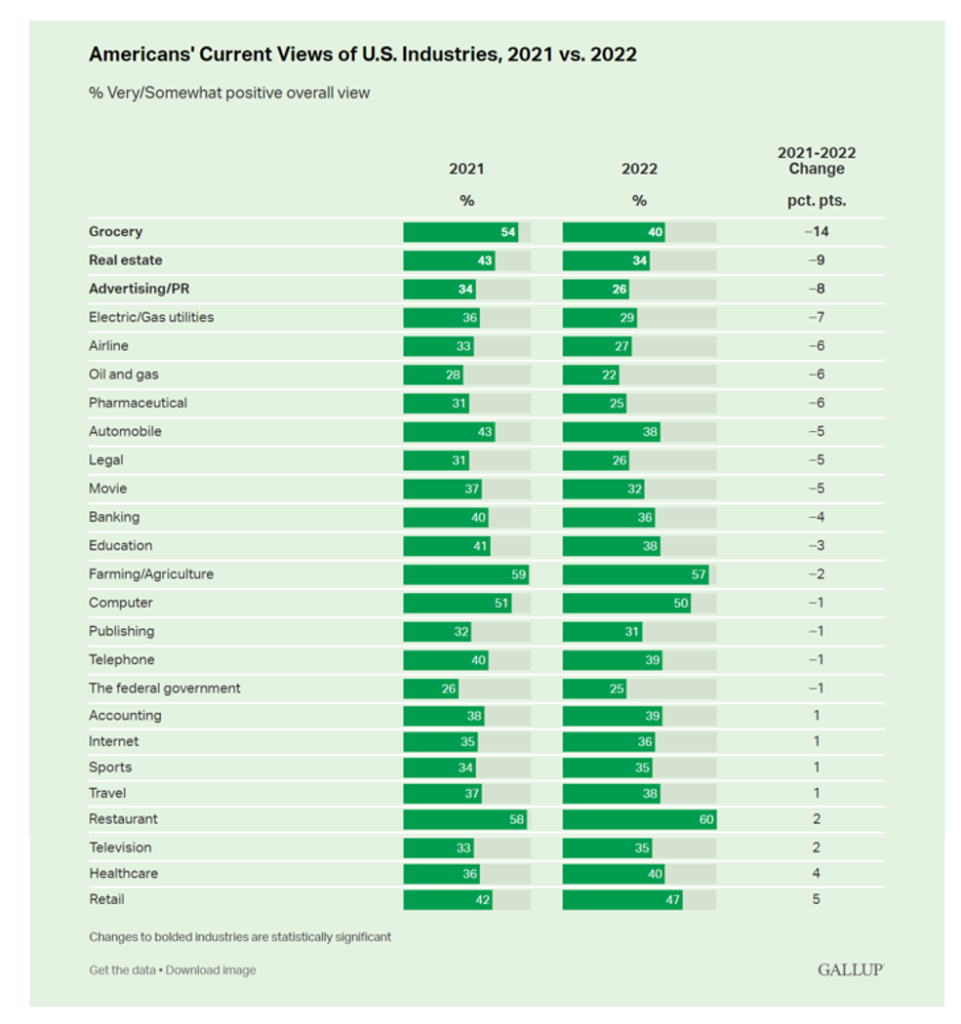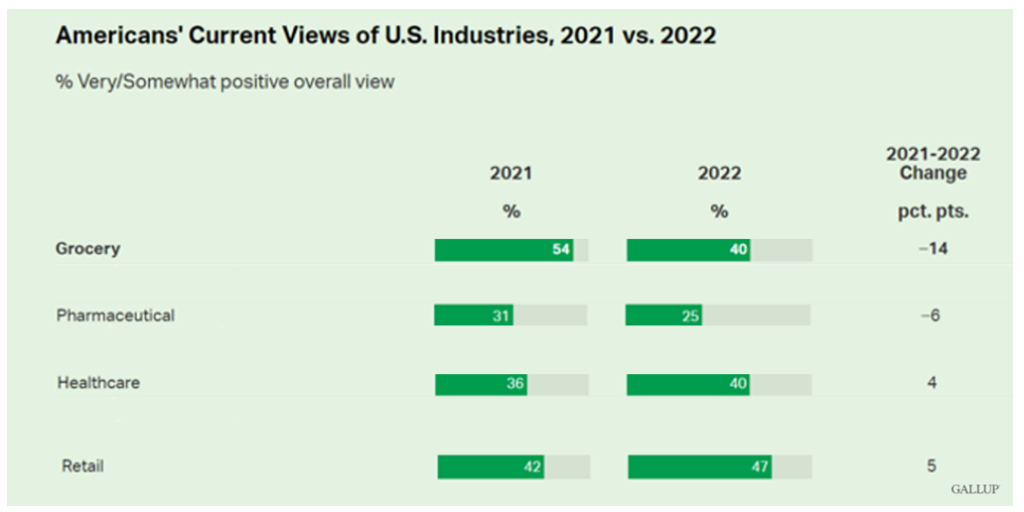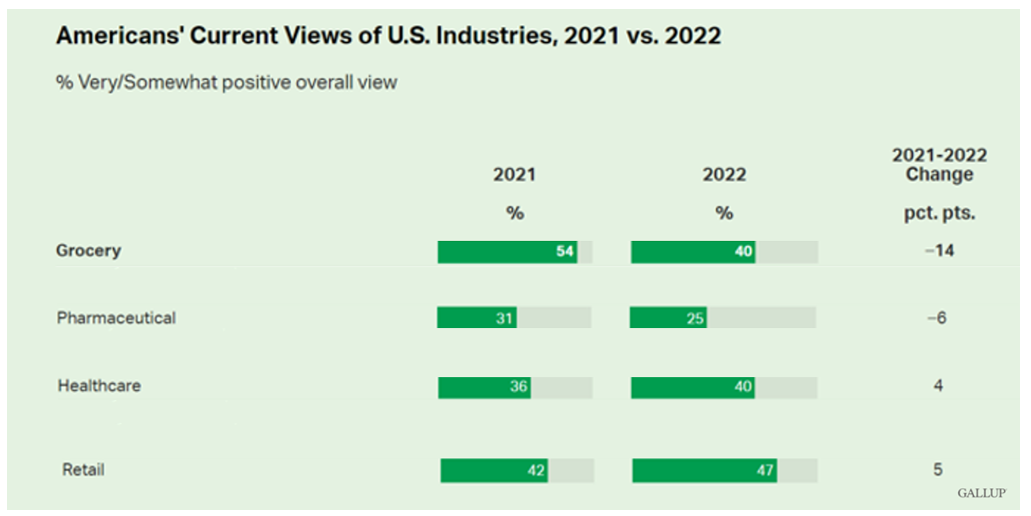Americans’ positive views of 25 industries in the U.S. have declined in the past year. In their latest look into consumers’ views on business in America, Gallup found that peoples’ ratings on business fell to their lowest ratings overall since 2008.

Peoples’ highest ratings of industry in American occurred in 2017 when nearly 50% of people gave business a very or somewhat positive grade.
The year-on-year decline from 2021 find oil and gas at the lowest level of positivity, advertising/PR, legal, the Federal government, and pharma at the bottom of the ratings.

The biggest declines in ratings were for grocery (falling a two-digit 14 points), real estate (dropping by 9 points), advertising/PR (declining 8 points), electric and gas utilities (down 7), airlines, oil and gas, and pharma all down by 6 percentage points.
Which sectors enhanced consumers’ favorable views between 2021 and 2022? These would be retail (growing by 5 points) and healthcare, up by 4 points in the year.
In the Gallup poll, the most favorable industries in 2022 are restaurants (with 60% of Americans holding positive views) and farming/agriculture (at 57% favorability).
The third in line for most-favorable industry in 2022 is the computer sector, with 50% of Americans having positive overall views. Fourth in line: retail.

In this this third chart, I’ve focused in on grocery, retail, healthcare and pharmaceutical sectors which have become core touchpoints in consumers’ health ecosystems.
We see that in 2022, retail, grocery, and healthcare garnered roughly equal positive equity among consumers, with pharmaceuticals dropping six points down from 2021 perceptions.
Grocery stores, in 2021 top of the positively-perceived sectors along with agriculture/farming and restaurants, fell a dramatic 14 points — probably due to food shoppers confronting high prices at the food chain.
While pharma’s industry positives fell over the year, healthcare’s profile gained favorable feelings with a handful of other industries.
Health Populi’s Hot Points: For some context, remember that 2008 was the advent of the Great Recession. While that economic decline had different features than the one facing the U.S. in the second half of 2022, families and households faced financial stress that strained peoples’ ability to make ends meet….and that included health care, as 5.7 million more Americans lost health insurance during the Great Recession era.
In 2022, it’s important to note that there has been less erosion of health-insured people lost to the uninsured rolls largely due to the impact of the Affordable Care Act, with the Inflation Reduction Act including provisions to continue to subsidize health insurance to stabilize the potential risk of insured people losing their coverage in the downturn of the U.S. economy for some sectors — and inflation hitting household budgets for basic needs like food, energy costs, and petrol (with gas at the pump prices having fallen).
I show this market basket of the four sectors as health consumers look for services — say, vaccinations, primary care, over-the-counter medicines, health and wellness products, fitness and wearable technology — beyond doctors’ offices, hospitals, clinics, and health plans.
The decline of the pharma industry reputation is an important reality-check here given that even Republican voters have been keen to see greater regulation of prescription drug pricing in recent health tracking polls. And this issue is a key pillar in the Inflation Reduction Act, both for Medicare’s ability to negotiate Rx prices with industry as well as a cap on insulin drug prices for some patients.
We should expect more collaboration across different industry sectors to serve health consumers at home and closer-to-home in the community, along with consolidation both vertically and horizontally by health plans, pharmacies, and health systems. These will surely involve aggregating data to better profile and serve consumers’ health and outcomes, as well as to reduce overall costs of care. The Gallup data can help us understand the changing nature of consumers’ trust, business, and health/care as organizations strike up these relationships.
Always remember that consumers’ health engagement is underpinned by trust, authenticity, and experience satisfaction.
And, as long as patients are medical bill payers, ensure that value-based care is designed and delivered based on peoples’ personal sets of values and sense of value.





 Thanks to Feedspot for naming this blog, Health Populi, as a
Thanks to Feedspot for naming this blog, Health Populi, as a